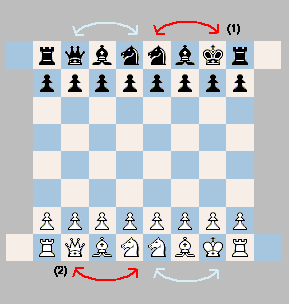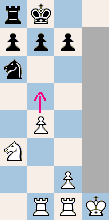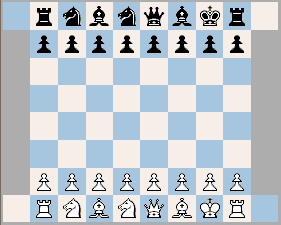

Abstract: The mirrored relocation method allows the players optionally to relocate the king and the queen before the play begins, whilst retaining the castling rights. The players can abstain from this if they both prefer the standard setup. It is a cogent method of rearranging the initial position to enhance opening ramification, while allowing the players to remain in control. The resultant positions are all mirrored and are twentyfive by number. They are a subset of Fischer Random Chess and deviate marginally from the standard position. Thus the general chessplayer would feel at home in any of these positions. The extra corner squares together with the relocation procedure will ensure that the strategical variance is greatly enhanced.
Introduction
In Future Chess (F-chess) Black can decide the initial positions of the kings, while White can decide the initial positions of the queens. The positions must mirror each other. Future Chess is like standard chess except that the players can, before play begins, swap places of the king + queen and another piece. The king may not swap with any of the rooks. The queen can be swapped with one of the rooks provided that the king remains between the rooks (this is a requirement of Chess960).
Thus, when the king is swapped (relocated), the other piece (the relocatee) ends up on the king's square. When the queen is swapped, the relocatee ends up on the queen's square. One restriction is that the bishops mustn't end up on the same square colour, and the king cannot become a relocatee (i.e. swapped by the queen). Note that black begins by swapping his king. Alternatively he can choose to leave the position as it is (by pressing the king). The white player then mirrors black's swap. After the kings thus have been swapped the turn is still with white. White can now relocate the queen, if he so wishes, and black then mirrors this. Next white starts the game by making the first move. Diagrams of the 25 possible setups can be viewed here.
Note that the king retains his castling rights even if it has been relocated. Castling rules derive from Chess960 but have been extended. King and rook end up on their usual squares, but the king also has the option to jump one square farther toward the corner (so that it ends up on the b- or h-file). All squares between king and rook must be empty and unthreatened.
 Here White has many options. If he chooses to castle, the rook will always end up on f1 or d1, but the king can be placed on g1, h1, b1 or c1.
Here White has many options. If he chooses to castle, the rook will always end up on f1 or d1, but the king can be placed on g1, h1, b1 or c1.
The curious but useful board was invented by King Gustav III of Sweden (see Gustav III's Chess). The extra corner squares (citadels) are also known from medieval big board variants, such as Citadel Chess (14th century?). The board sizes were either 10x10 or 12x12 and had four extra protruding squares that served as sanctuaries for the king. (cf. Pritchard: The Classified Encyclopedia of Chess Variants, p.244). The extended castling rule makes play on the wings easier to achieve. The king can rapidly take control over the kingside or queenside corner square.
 Disregarding the situation on the rest of the board, this illustrates how convenient the extra corner square is when launching an attack on the wing. When the king gets out of harm's way, this also makes it easier for the pieces to maneuver.
Disregarding the situation on the rest of the board, this illustrates how convenient the extra corner square is when launching an attack on the wing. When the king gets out of harm's way, this also makes it easier for the pieces to maneuver.
Discussion
The extra corner squares together with the relocation procedure will ensure that strategical variability is greatly enhanced. With these relocation rules the bishops are always positioned so that there is still a choice to develop them on either of the queen's or the king's wing. There is at least one rook placed in its standard position. This maintains the strategical ambiguity of the initial position, while sound positions are produced where no definitive advantage can be obtained. Black relocates first. Thusly white gets a chance to make a strategical decision and create an initiative, as in the standard position. The initial positions are a subgroup of Fischer Random Chess. The most conservative relocation, it seems, is to change place between king and queen, which is a convenient way of avoiding theory.
Arguably, the method of reconfiguration of the initial array answers to the chessplayer's predilection for remaining in control (cmp. Fischer Random Chess). Black can choose to relocate to a position which somewhat improves his chances against, for instance, the e4 openings. But White can adjust to this and try to predict his opening plans and on which side Black is going to castle. This can inform his choice of queen positioning. The standard position is an active and strategically ambiguous position, which could often be advantageous to White. However, as Black, the standard position is not necessarily the best defensive position. As White is recompenced by giving him the last word in the setup of the pieces, I believe that this gives him a slight possibility to maintain an advantage. It is necessary to maintain the first move advantage in order to retain the strategical tension. A closely related variant is Fischer Placement Chess, which is played on a regular board.
 Black has relocated the king to g8 and the relocatee to e8. White has mirrored this move and then relocated the queen to e1 and the relocatee to d1. Black has mirrored the latter relocation. Black can later castle short by moving the rook to f8 whilst keeping the king on g8 or placing it on h8. He can castle long by moving the king to c8 or b8. Thanks to the king's protected position, the player can wait a longer time before deciding on which side to castle. Now white begins the play.
Black has relocated the king to g8 and the relocatee to e8. White has mirrored this move and then relocated the queen to e1 and the relocatee to d1. Black has mirrored the latter relocation. Black can later castle short by moving the rook to f8 whilst keeping the king on g8 or placing it on h8. He can castle long by moving the king to c8 or b8. Thanks to the king's protected position, the player can wait a longer time before deciding on which side to castle. Now white begins the play.
An alternative variant of Future Chess allows only 9 positions, but most of them non-mirrored (following the same relocation rules as Chess-9).
Randomization
The randomized version of Future Chess (Future Random Chess) implies that the initial position of each side is independently randomized according to the above rules of king and queen relocation. It is supported in the program. There are 25 possible board positions. It is comparable to Fischer Random Chess. Future Chess is designed to overcome the problem of opening monotony.
• You can download my free Future Chess program here (updated 2011-02-14), but you must own the software Zillions of Games to be able to run it (I recommend the download version).
• See also related variants in my article about Relocation variants.
• You can play related variant Chess20 (Placement Random Chess) online or by email here.
• Don't miss my other chess variants.
© M. Winther, 2010 August